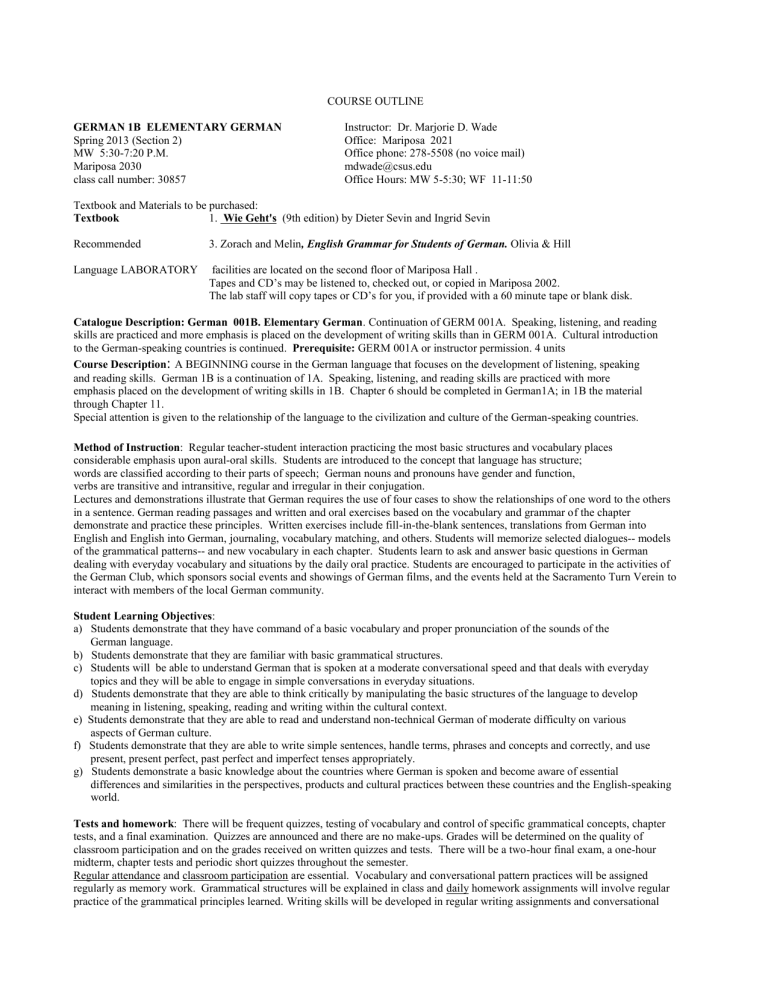Document 15165715

GERMAN 1B ELEMENTARY GERMAN
Spring 2013 (Section 2)
MW 5:30-7:20 P.M.
Mariposa 2030
COURSE OUTLINE
Instructor: Dr. Marjorie D. Wade
Office: Mariposa 2021
Office phone: 278-5508 (no voice mail) mdwade@csus.edu
Office Hours: MW 5-5:30; WF 11-11:50 class call number: 30857
Textbook and Materials to be purchased:
Textbook 1. Wie Geht's (9th edition) by Dieter Sevin and Ingrid Sevin
Recommended 3. Zorach and Melin , English Grammar for Students of German.
Olivia & Hill
Language LABORATORY facilities are located on the second floor of Mariposa Hall .
Tapes and CD’s may be listened to, checked out, or copied in Mariposa 2002.
The lab staff will copy tapes or CD’s for you, if provided with a 60 minute tape or blank disk.
Catalogue Description: German 001B. Elementary German . Continuation of GERM 001A. Speaking, listening, and reading skills are practiced and more emphasis is placed on the development of writing skills than in GERM 001A. Cultural introduction to the German-speaking countries is continued. Prerequisite: GERM 001A or instructor permission. 4 units
Course Description
:
A BEGINNING course in the German language that focuses on the development of listening, speaking and reading skills. German 1B is a continuation of 1A. Speaking, listening, and reading skills are practiced with more emphasis placed on the development of writing skills in 1B. Chapter 6 should be completed in German1A; in 1B the material through Chapter 11.
Special attention is given to the relationship of the language to the civilization and culture of the German-speaking countries.
Method of Instruction : Regular teacher-student interaction practicing the most basic structures and vocabulary places considerable emphasis upon aural-oral skills. Students are introduced to the concept that language has structure; words are classified according to their parts of speech; German nouns and pronouns have gender and function, verbs are transitive and intransitive, regular and irregular in their conjugation.
Lectures and demonstrations illustrate that German requires the use of four cases to show the relationships of one word to the others in a sentence. German reading passages and written and oral exercises based on the vocabulary and grammar of the chapter demonstrate and practice these principles. Written exercises include fill-in-the-blank sentences, translations from German into
English and English into German, journaling, vocabulary matching, and others. Students will memorize selected dialogues-- models of the grammatical patterns-- and new vocabulary in each chapter. Students learn to ask and answer basic questions in German dealing with everyday vocabulary and situations by the daily oral practice. Students are encouraged to participate in the activities of the German Club, which sponsors social events and showings of German films, and the events held at the Sacramento Turn Verein to interact with members of the local German community.
Student Learning Objectives : a) Students demonstrate that they have command of a basic vocabulary and proper pronunciation of the sounds of the
German language. b) Students demonstrate that they are familiar with basic grammatical structures. c) Students will be able to understand German that is spoken at a moderate conversational speed and that deals with everyday
topics and they will be able to engage in simple conversations in everyday situations. d) Students demonstrate that they are able to think critically by manipulating the basic structures of the language to develop meaning in listening, speaking, reading and writing within the cultural context. e) Students demonstrate that they are able to read and understand non-technical German of moderate difficulty on various aspects of German culture. f) Students demonstrate that they are able to write simple sentences, handle terms, phrases and concepts and correctly, and use present, present perfect, past perfect and imperfect tenses appropriately. g) Students demonstrate a basic knowledge about the countries where German is spoken and become aware of essential
differences and similarities in the perspectives, products and cultural practices between these countries and the English-speaking
world.
Tests and homework : There will be frequent quizzes, testing of vocabulary and control of specific grammatical concepts, chapter tests, and a final examination. Quizzes are announced and there are no make-ups. Grades will be determined on the quality of classroom participation and on the grades received on written quizzes and tests. There will be a two-hour final exam, a one-hour midterm, chapter tests and periodic short quizzes throughout the semester.
Regular attendance and classroom participation are essential. Vocabulary and conversational pattern practices will be assigned regularly as memory work. Grammatical structures will be explained in class and daily homework assignments will involve regular practice of the grammatical principles learned. Writing skills will be developed in regular writing assignments and conversational
skills are practiced in socially and culturally directed dialogues. Additional listening and speaking practice and structure drills are provided by regular lab assignments, which are to be completed in the language laboratory with the tapes that accompany the text.
Students should be prepared to devote two hours of study for every hour of classroom activity.
Grading Scale: 90-100% =A, 80-89% =B, 70-79% =C, 60-69% = D, less than 60% F
Exam: The two-hour final exam will be given on Monday evening, May 20 th in Mariposa 2030.
(For students making class presentations that require use of smart classroom facilities, please contact IT techs personally in
MRP 2054, in advance of your presentation date, for assistance with specific cords and attachments to be used with projectors and laptops.)
Students with special needs should consult the University’s office for services to Students for Disabilities.
